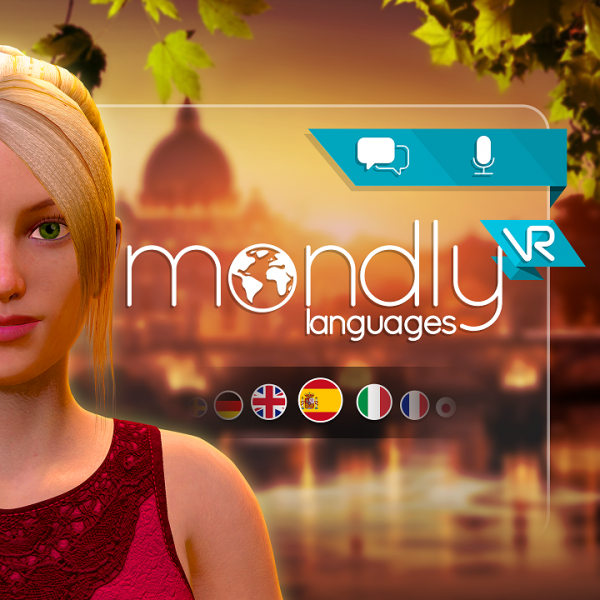This Innovative Virtual Reality App Helps You Learn a Foreign Language in a Fun Way
Discover the most advanced way to learn languages.
Can the Easter bunny say “Happy Easter” in all these languages? 🐰 Let’s find out.

Apart from their significant religious symbolism, the Easter holidays provide a wonderful opportunity to unwind, spend quality time with our loved ones and maybe reconnect with old friends. Regardless of our religious beliefs, Easter will always be about togetherness, enjoying the long-awaited spring (in the Northern Hemisphere) and the Easter bunny, of course! If you too wish to rekindle your friendship with a friend living abroad this Easter, why not join us in learning how to wish them “Happy Easter” in different languages?
Easter, much like Christmas, has its origins in both Christianity and ancient pagan culture. Originally, it was a celebration of the spring equinox in pagan culture, but later it became a Christian holiday that commemorates the resurrection of Jesus Christ. Today, Easter is typically celebrated around the time of the Jewish Passover.
As the Christian faith spread, early believers who did not follow Jewish customs blended their observances with the pagan spring festival, eventually recognizing Easter as “resurrection day.” The Easter traditions that we enjoy today are a mixture of Christian and ancient pagan customs. Although the Christian traditions are still very much a part of the holiday, the pagan symbols of eggs, bunnies, and sweets have become more prominent and “marketable”.
Christians celebrate Easter as a happy holiday because it fulfills the Old Testament prophecies and shows God’s plan to save everyone. Easter celebrates the Resurrection of Jesus Christ, which defeated death on the third day and gives hope for salvation. Christians believe that Jesus’ death paid for humanity’s sins and his Resurrection gives believers hope for their own resurrection.
Easter is a “movable feast”, which means that it does not occur on a fixed date every year. Instead, it is celebrated on the first Sunday following the first full moon after the spring equinox (which falls on March 21), according to the Gregorian calendar. This means Easter can be observed on a Sunday between March 22 and April 25. However, the Eastern Orthodox Church follows a slightly different method of calculation, which is based on the Julian calendar. As a result, Easter in the Eastern Orthodox tradition can fall on any Sunday between April 4 and May 8.
Do you suspect your parents are lying to you about the existence of the Easter bunny? If so, you should really ask them about it. The internet is not always the best place to look for answers. Besides, honesty is very important in a parent-child relationship. So build up the courage and ask either a parent or a guardian. They will seem surprised by your question at first, but they will be more than happy to respond.
On the other hand, if you really need an explanation right now, here it is. We hate to break to you, but the Easter bunny… is not real. 😭
However, that doesn’t mean you shouldn’t believe in it. In a way, the Easter bunny is real as long as you believe in it because it continues to exist in your heart.
The Easter bunny is a fictional hare who delivers chocolate eggs, candy, and other treats to children on Easter Sunday. Despite the Bible not mentioning it, the bunny has become a much beloved and prominent figure of the Easter celebrations.
While we all love the Easter bunny, we can’t help but wonder how it became a central symbol of the celebration of Jesus Christ’s resurrection.

One theory suggests that the rabbit symbol comes from the pagan festival of Eostre, which celebrated the goddess of fertility and spring. The rabbit was her animal symbol, representing fertility due to their high reproduction rates.
In the 1700s, German immigrants reportedly brought over their tradition of an egg-laying hare called “Osterhase” or “Oschter Haws” from the Old Country to America. According to legend, children would create nests for the bunny to leave his colorful eggs. The custom spread across America, and over time, the Easter Bunny’s delivery of treats expanded to include chocolate and toys.
It might seem like a mistake to say that the Easter Bunny lays eggs since rabbits are mammals and give birth to live young. However, both rabbits and eggs are ancient symbols of fertility and renewal and have long been associated with the celebration of Easter. For Christians, Easter eggs have a special meaning as the egg symbol was likened to the tomb from which Christ arose. Decorating eggs for Easter has been a tradition since the 13th century when eggs were forbidden during Lent. By decorating eggs, people would make eating them on Easter Sunday even more special after the fasting period was over.
The custom of the Easter egg hunt dates back to the late 16th century when the Protestant reformer Martin Luther organized egg hunts for his congregation. In a nod to the story of the resurrection, in which the empty tomb was discovered by women, men would hide the eggs for women and children to find.
Nowadays, the Easter egg hunt has become a fun activity enjoyed by children and parents alike.
What do you say on Easter? Eastern Orthodox, Oriental Orthodox, Catholic, and Anglican Christians use the Paschal greeting, also known as the Easter Acclamation. The greeting and reply are:
– Christ is Risen!
– Truly He is Risen!
For example, this Easter greeting in Spanish is:
– Cristo ha resucitado!
– En verdad ha resucitado!
However, Happy Easter remains the most popular Easter greeting worldwide. Let’s see how you can say “Happy Easter” in different languages.

‘Easter’ in Spanish is Pascuas. As previously mentioned, the Paschal greeting in Spanish is “Cristo ha resucitado! – En verdad ha resucitado!”; however, Spanish people don’t really use it. Instead, they say Felices Pascuas (‘Happy Easter’) or simply Felices Fiestas which means ‘Happy Holidays’.
The Easter menu during La Semana Santa (‘The Holy Week’) includes torrijas which is a kind of French toast and potaje de vigilia which is a chickpea soup.
Pâques (‘Easter’ in French) is an important holiday in France as families get together to celebrate and eat the traditional lamb cooked in the oven with Provençal herbs, garlic, cumin, and olive oil.
Other Easter traditions in France include chocolate, the Easter bells (Les cloches de Pâques) and the classic rabbits and eggs, of course!
Easter (Ostern in German) in Germany has a long history and some of its traditions have even spread around the world.
On Easter Sunday, Germans have a traditional Easter brunch where they eat buns, spreads, and painted boiled eggs. Children often help paint and decorate the eggs.
The Easter menu also included yeast pastries like Hefezopf or Osterkranz, which can be stuffed with nuts and dried fruits and eaten with butter or jam.
Easter (Pasqua in Italian) is a significant holiday in Italy, second only to Christmas. While the days before Easter include solemn masses, the holiday itself is a joyous celebration with many traditions. La Pasquetta, the day after Easter Sunday, is also a public holiday throughout Italy.
Traditional holiday foods in Italy include lamb or goat, artichokes, and special Easter breads that differ from region to region. Some popular Easter breads are Pannetone sweet bread and Colomba (dove-shaped) bread, which are often given as gifts.
In Portugal, Easter is celebrated with great passion and religious fervor. The Holy Week of Easter (Semana Santa) is like a somber carnival, with religious processions, Biblical re-enactments, and Roman period costumes, and is mostly celebrated outdoors.
Similarly, Easter in Brazil, a country with one of the world’s largest Catholic populations, is centered on religion and spending time with loved ones.
In both countries, people eat salt cod on Good Friday.
Considering that 99 percent of the Turkish population is Muslim, it’s safe to say that Turkey doesn’t really celebrate Easter. However, some Christian Turkish citizens do.
While you can say Paskalyanız kutlu olsun to wish someone a Happy Easter in Turkish, Paskalya Bayramınız kutlu olsun is the more “correct” version. Adding “bayram” gives the meaning of having a holiday to celebrate.
Romania is a highly religious country, so Easter is a significant celebration for Romanians. During the three days of Easter (and even after), most locals will greet each other using the Paschal greeting Hristos a Înviat – Adevărat a Înviat which means “Christ is Risen! – Truly He is Risen!”.
Following the period of Lent (in varying degrees of strictness), the traditional Easter menu in Romania includes cozonac (which is a type of sweet bread with nuts and Turkish delight), drob (made from minced up offal and entrails) and oven-cooked lamb.
Polish Easter traditions blend pagan and Christian customs, such as the Easter basket (święconka) and Easter eggs (pisanki). Easter celebrations begin with Easter palms displayed on Palm Sunday, followed by a rezurekcja (‘resurrection’) procession and religious songs on Easter Sunday.
At home, families share eggs during Easter breakfast and decorate the table with Easter symbols and springtime flowers. Traditional Easter foods include kiełbasa, żurek, barszcz, mazurek, and babka.
What language does the Easter bunny speak? Considering he’s a fictional character, he can speak whatever language you’d like him to speak. Or even all of them at once. However, one thing we know for sure: the Easter bunny is currently improving his language skills with Mondly.
Do you want to learn languages as fast as the Easter bunny delivers eggs to all children worldwide? Get Mondly, the award-winning language learning app that will make learning languages a breeze.
Instead of tiring yourself for hours with inch-thick textbooks, slip a 10-minute Mondly lesson into your routine and make learning a breeze. You will learn languages naturally using:
Start using Mondly for free on your computer or download the app and learn languages anytime, anywhere.

Discover the most advanced way to learn languages.

When learning a new language you are faced with a choice: dip your toes or follow the immersion route. Which one will you choose?

Planning a trip to Japan? From Konnichiwa to Konbanwa and Moshi Moshi, here is a complete guide on how to say "hello" in Japanese.
why no RUSSIAN language? after all there are -only- some 150 Million – russian orthodox believers- around the world? and we all are celebrating EASTER this weekend. 2023 that is…